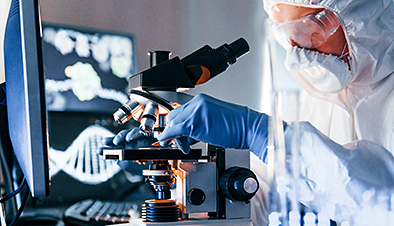Richard Feynman famously stated, “Everything that living things do can be understood in terms of the jigglings and wigglings of atoms.” This week, Nature Nanotechnology features a study that sheds new light on the evolution of the coronavirus and its variants of concern by analyzing the behavior of atoms in the proteins at the interface between the virus and humans.
The study introduces significant insights into the mechanical stability of the coronavirus, a key factor in its evolution into a global pandemic. The research team employed advanced computational simulations and magnetic tweezers technology to explore the biomechanical properties of biochemical bonds in the virus. Their findings reveal critical distinctions in the mechanical stability of various virus strains, highlighting how these differences contribute to the virus’s aggressiveness and spread.
As the World Health Organization reports nearly 7 million deaths worldwide from COVID-19, with more than 1 million in the United States alone, understanding these mechanics becomes crucial for developing effective interventions and treatments. The group emphasizes that comprehending the molecular intricacies of this pandemic is key to shaping our response to future viral outbreaks.
Delving deeper into the study, the Auburn University team, led by Prof. Rafael C. Bernardi, Assistant Professor of Biophysics, along with Dr. Marcelo Melo and Dr. Priscila Gomes, played a pivotal role in the research by leveraging powerful computational analysis. Utilizing NVIDIA HGX-A100 nodes for GPU computing, their work was essential in unraveling complex aspects of the virus’s behavior.
Prof. Bernardi, an NSF Career Award recipient, collaborated closely with Prof. Gaub from LMU, Germany, and Prof. Lipfert from Utrecht University, The Netherlands. Their collective expertise spanned various fields, culminating in a comprehensive understanding of the SARS-CoV-2 virulence factor. Their research demonstrates that the equilibrium binding affinity and mechanical stability of the virus–human interface are not always correlated, a finding crucial for comprehending the dynamics of viral spread and evolution.
Additionally, the team’s use of magnetic tweezers to study the force-stability and bond kinetics of the SARS-CoV-2:ACE2 interface in various virus strains provides new perspectives on predicting mutations and adjusting therapeutic strategies. The methodology is unique because it measures how strongly the virus binds to the ACE2 receptor, a key entry point into human cells, under conditions that mimic the human respiratory tract.
The group found that while all the major COVID-19 variants (like alpha, beta, gamma, delta, and omicron) bind more strongly to human cells than the original virus, the alpha variant is particularly stable in its binding. This might explain why it spread so quickly in populations without prior immunity to COVID-19. The results also suggest that other variants, like beta and gamma, evolved in a way that helps them evade some immune responses, which might give them an advantage in areas where people have some immunity, either from previous infections or vaccinations.
Interestingly, the delta and omicron variants, which became dominant worldwide, show traits that help them escape immune defenses and possibly spread more easily. However, they don’t necessarily bind more strongly than other variants. Prof. Bernardi says, “This research is important because it helps us understand why some COVID-19 variants spread more quickly than others. By studying the virus‘s binding mechanism, we can predict which variants might become more prevalent and prepare better responses to them.”
This research emphasizes the importance of biomechanics in understanding viral pathogenesis and opens new avenues for scientific investigation into viral evolution and therapeutic development. It stands as a testament to the collaborative nature of scientific research in addressing significant health challenges.
More information: Magnus S. Bauer et al, Single-molecule force stability of the SARS-CoV-2–ACE2 interface in variants-of-concern, Nature Nanotechnology (2023). DOI: 10.1038/s41565-023-01536-7. www.nature.com/articles/s41565-023-01536-7
Journal information: Nature Nanotechnology
News
Lower doses of immunotherapy for skin cancer give better results, study suggests
According to a new study, lower doses of approved immunotherapy for malignant melanoma can give better results against tumors, while reducing side effects. This is reported by researchers at Karolinska Institutet in the Journal of the National [...]
Researchers highlight five pathways through which microplastics can harm the brain
Microplastics could be fueling neurodegenerative diseases like Alzheimer's and Parkinson's, with a new study highlighting five ways microplastics can trigger inflammation and damage in the brain. More than 57 million people live with dementia, [...]
Tiny Metal Nanodots Obliterate Cancer Cells While Largely Sparing Healthy Tissue
Scientists have developed tiny metal-oxide particles that push cancer cells past their stress limits while sparing healthy tissue. An international team led by RMIT University has developed tiny particles called nanodots, crafted from a metallic compound, [...]
Gold Nanoclusters Could Supercharge Quantum Computers
Researchers found that gold “super atoms” can behave like the atoms in top-tier quantum systems—only far easier to scale. These tiny clusters can be customized at the molecular level, offering a powerful, tunable foundation [...]
A single shot of HPV vaccine may be enough to fight cervical cancer, study finds
WASHINGTON -- A single HPV vaccination appears just as effective as two doses at preventing the viral infection that causes cervical cancer, researchers reported Wednesday. HPV, or human papillomavirus, is very common and spread [...]
New technique overcomes technological barrier in 3D brain imaging
Scientists at the Swiss Light Source SLS have succeeded in mapping a piece of brain tissue in 3D at unprecedented resolution using X-rays, non-destructively. The breakthrough overcomes a long-standing technological barrier that had limited [...]
Scientists Uncover Hidden Blood Pattern in Long COVID
Researchers found persistent microclot and NET structures in Long COVID blood that may explain long-lasting symptoms. Researchers examining Long COVID have identified a structural connection between circulating microclots and neutrophil extracellular traps (NETs). The [...]
This Cellular Trick Helps Cancer Spread, but Could Also Stop It
Groups of normal cbiells can sense far into their surroundings, helping explain cancer cell migration. Understanding this ability could lead to new ways to limit tumor spread. The tale of the princess and the [...]
New mRNA therapy targets drug-resistant pneumonia
Bacteria that multiply on surfaces are a major headache in health care when they gain a foothold on, for example, implants or in catheters. Researchers at Chalmers University of Technology in Sweden have found [...]
Current Heart Health Guidelines Are Failing To Catch a Deadly Genetic Killer
New research reveals that standard screening misses most people with a common inherited cholesterol disorder. A Mayo Clinic study reports that current genetic screening guidelines overlook most people who have familial hypercholesterolemia, an inherited disorder that [...]
Scientists Identify the Evolutionary “Purpose” of Consciousness
Summary: Researchers at Ruhr University Bochum explore why consciousness evolved and why different species developed it in distinct ways. By comparing humans with birds, they show that complex awareness may arise through different neural architectures yet [...]
Novel mRNA therapy curbs antibiotic-resistant infections in preclinical lung models
Researchers at the Icahn School of Medicine at Mount Sinai and collaborators have reported early success with a novel mRNA-based therapy designed to combat antibiotic-resistant bacteria. The findings, published in Nature Biotechnology, show that in [...]
New skin-permeable polymer delivers insulin without needles
A breakthrough zwitterionic polymer slips through the skin’s toughest barriers, carrying insulin deep into tissue and normalizing blood sugar, offering patients a painless alternative to daily injections. A recent study published in the journal Nature examines [...]
Multifunctional Nanogels: A Breakthrough in Antibacterial Strategies
Antibiotic resistance is a growing concern - from human health to crop survival. A new study successfully uses nanogels to target and almost entirely inhibit the bacteria P. Aeruginosa. Recently published in Angewandte Chemie, the study [...]
Nanoflowers rejuvenate old and damaged human cells by replacing their mitochondria
Biomedical researchers at Texas A&M University may have discovered a way to stop or even reverse the decline of cellular energy production—a finding that could have revolutionary effects across medicine. Dr. Akhilesh K. Gaharwar [...]
The Stunning New Push to Protect the Invisible 99% of Life
Scientists worldwide have joined forces to build the first-ever roadmap for conserving Earth’s vast invisible majority—microbes. Their new IUCN Specialist Group reframes conservation by elevating microbial life to the same urgency as plants and [...]





















